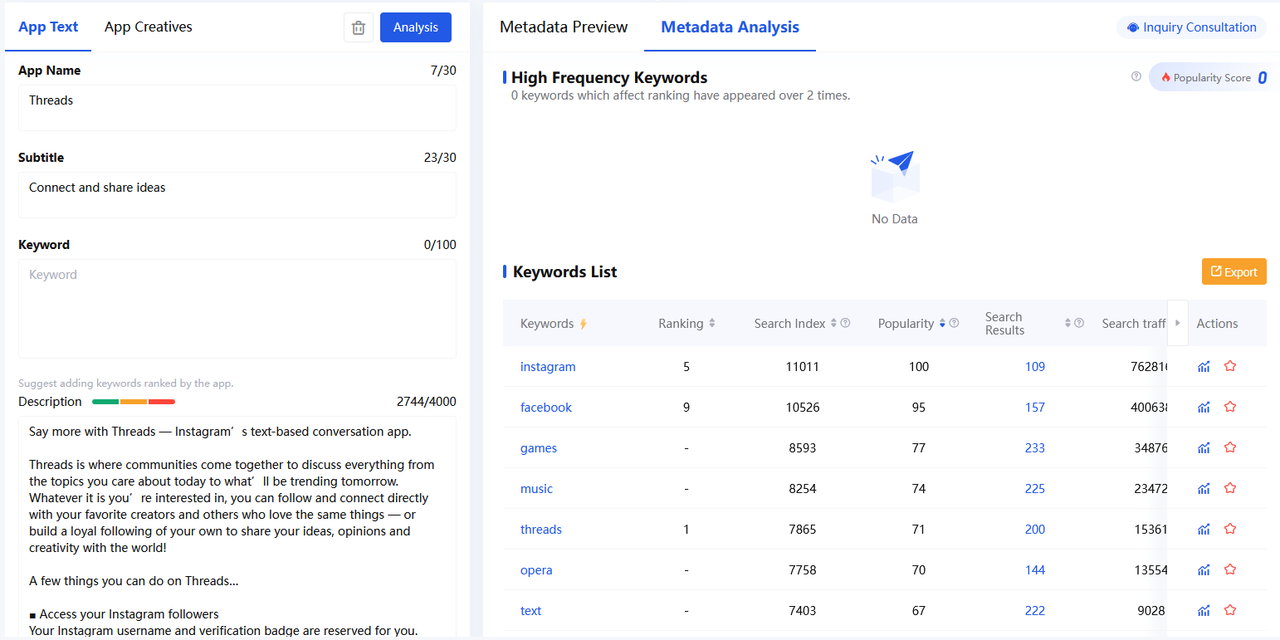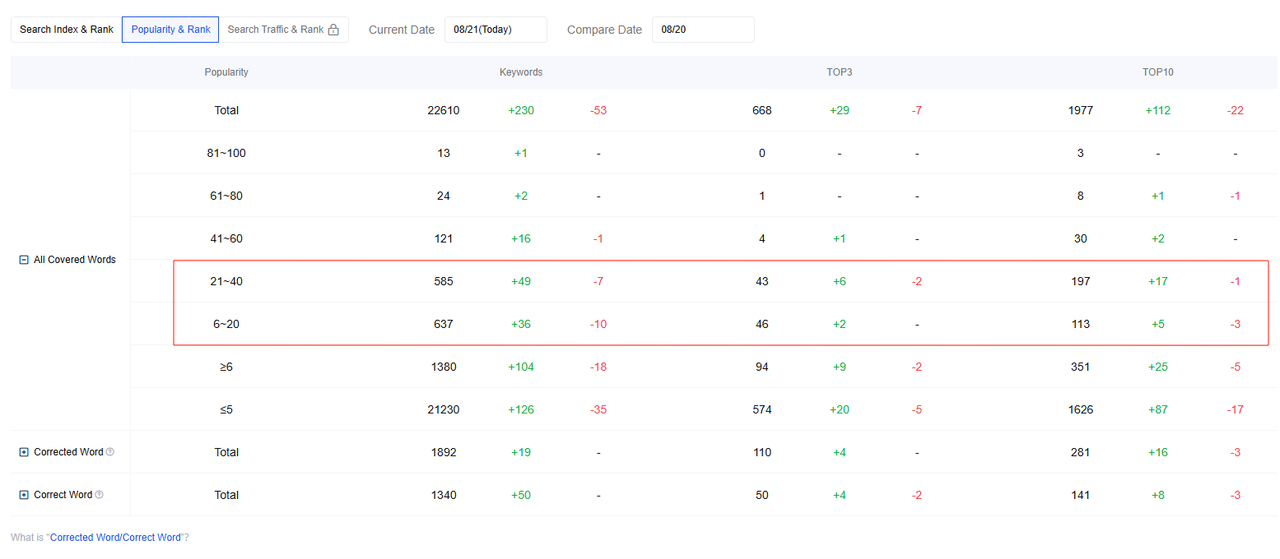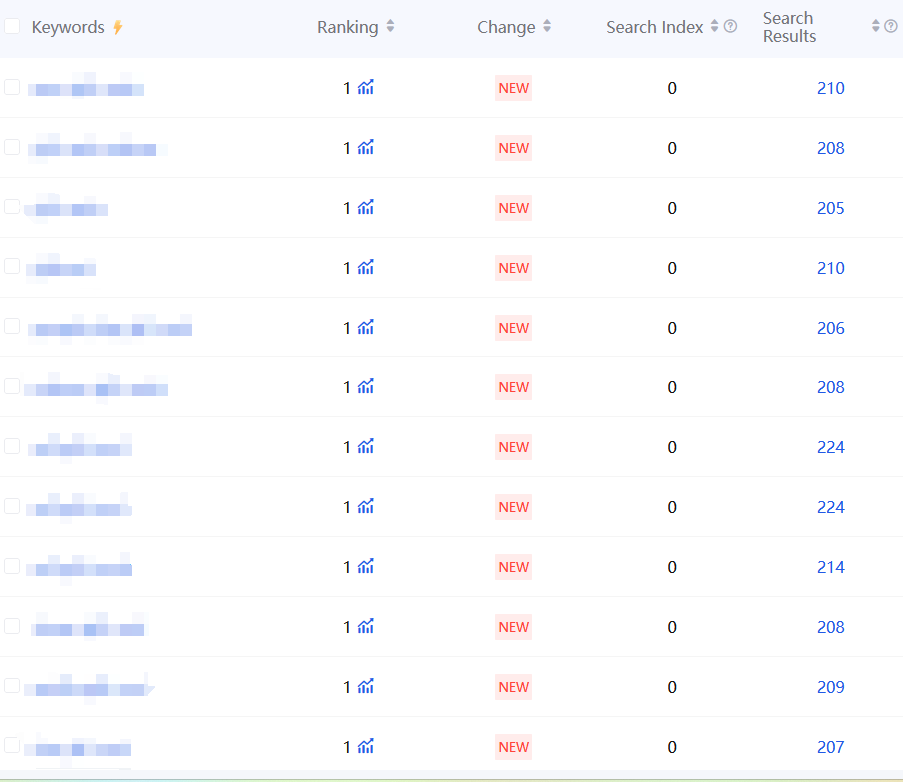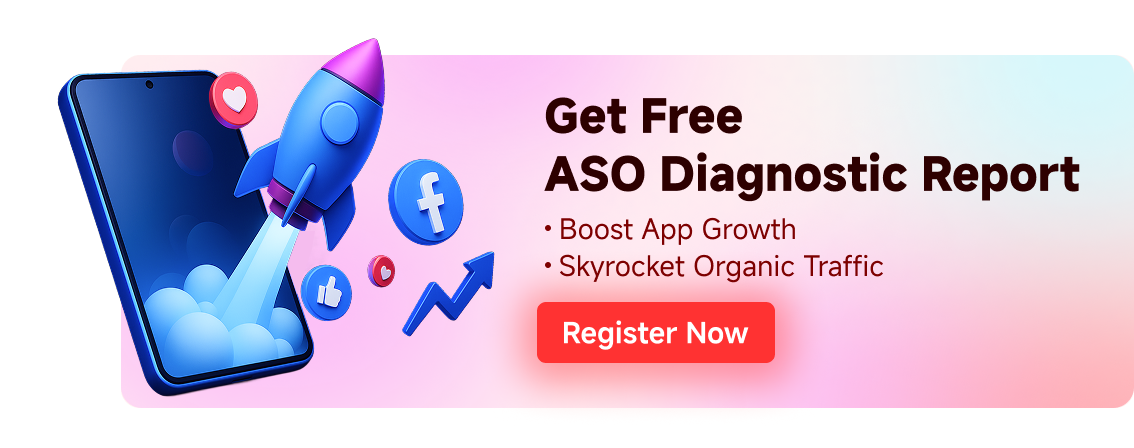
Loading...
Free consultation with ASO specialists
Doing ASO for the first time or have no idea how to carry out targeted optimization of your app?
We offer one-on-one customized services provided by app marketing specialists
How to do ASO keyword research efficiently?
2025-08-22
Introduction
With millions of apps competing in the App Store and Google Play, how do you make your app stand out? App Store Optimization (ASO) is key, and ASO keyword research is the cornerstone of ASO strategy. Through precise keyword research and optimization, you can significantly improve your app's visibility in search results and attract more downloads. This article will provide a detailed introduction to how to efficiently conduct ASO keyword research, including the selection of main keywords, research methods, optimization strategies, recommended data tools, and common pitfalls, helping you develop an effective ASO keyword optimization plan.
Main Keyword Selection
It is essential to select and apply main keywords that are highly relevant to the application and have search popularity. These keywords are mostly short core words or phrases used by users when searching in the app store (such as "fitness" and "accounting"), directly reflecting the core functions of the application or the needs of the target users. To ensure relevance and popularity, tools such as Google Trends can be used to understand recent search trends and hot topics. For example, in the United States, the popularity of ASO-related keywords will change with the development of the mobile app market, and rising search terms related to the application category can be mined through this tool.
The following principles must be followed when selecting the main keywords:
-
Relevance: It must match the application function and target user intent. For example, meditation applications should select words such as "Meditation" and "Sleep", and avoid irrelevant words.
-
Search volume: Prioritize words with a certain level of popularity, which can be evaluated through ASO tools or platform data for their search volume and popularity, while balancing between search volume and competition (popular words are often highly competitive).
-
Competitiveness: Avoid keywords that have been occupied by a large number of high-ranking applications. You can use UPUP to view the competition index or popularity, and prioritize "opportunity keywords" with a certain amount of searches but less competition.
In addition, long-tail keywords are becoming increasingly important in the 2025 ASO trends. These keywords are longer and more specific phrases (usually consisting of three or more words, such as "Fast Fitness Tracker" or "Accounting Software Free"), which have lower search volumes but less competition and can precisely match user intent, making them conducive to acquiring high-quality downloads. Therefore, keyword selection should combine both short and long keywords: include core short-tail keywords as well as potential long-tail keywords to cover a wider range of search scenarios.
Methods of ASO Keyword Research
After determining the general direction of keywords, you need to use effective methods to collect and filter keywords. The following are several commonly used methods in ASO keyword research:
-
Brainstorming and User Research
Starting from the application itself, list all possible relevant words. These include the core functions of the application, descriptive words that target users may use, and problems that the application solves. For example, a food recipe application can think of words such as "recipe", "cooking", "food", and "kitchen". At the same time, consider the real language habits of users, what phrases might they use to find this type of application?
-
Competitor Analysis
Studying your competitors' (especially top-ranking apps in the same category) keyword strategy can help you discover important words that you have missed. Check which keywords your competitors use in their app titles, subtitles, and descriptions. Use UPUP to view "Competitor Keywords" to export a list of keywords that your competitors are ranking for. By analyzing these lists, you can find keywords covered by your competitors and think about how to fill the gaps or find differentiated keywords.

-
App Store Autocomplete
Use the autocomplete function of the App Store/Google Play search box. When you enter the beginning of a word in the App Store or Google Play, the system automatically pops up relevant search suggestions. These suggestions reflect the real user's search behavior and are a good way to obtain long-tail keywords. For example, when searching "fitness" in the App Store, it will automatically prompt extended phrases such as "fitness plan". Record these suggested words, which can often discover commonly used search combinations by users.
-
Use ASO tools to mine
UPUP's AI keyword expansion function can be used to expand keywords. After entering a seed keyword, you can obtain a list of related expanded words, as well as the search index and popularity of each word. In addition, these tools can also recommend popular keywords according to your application category, helping you discover new opportunities.
-
Follow trends and seasonality
Users' search interests change over time, and certain keywords may suddenly become popular in specific periods. For example, every New Year, searches for "weight loss" and "fitness" apps increase; during the peak travel season, words like "travel planning" and "hotel booking" become more popular. Google Trends or app store trend reports can capture these changes. Timely inclusion of emerging popular keywords in your keyword list can give you a head start and gain additional traffic.
By using the above methods comprehensively, you can build a rich list of keywords. In this process, do not worry about the number of keywords, try to collect as many as possible, including short tail and long tail, different spellings and synonyms. Next, these keywords need to be filtered and prioritized for subsequent optimization.
Keyword Screening and Priority Ranking
After collecting a large number of candidate keywords, you must filter out the most valuable keywords and sort them according to priority to guide the optimization of application metadata. When filtering and sorting, consider the following key indicators:
-
Search Volume/Popularity(Popularity)
Prioritize keywords with higher search volume. This indicates a larger user demand base, and you can use ASO tools to view the search volume or popularity of each keyword.
-
Optimization Difficulty
Assessing Keywords forOptimization Difficulty(Competitor quantity and strength). When the new application or resource is limited, it is recommended to avoid high competition "head words" and turn to medium and low competition words (popularity 10-40) to achieve breakthroughs; after the weight of the application is improved, gradually conquer popular words.

-
Relevance and User Intent
-
Relevance: Strictly select keywords that match the core functions of the application and the needs of target users, and eliminate weak or irrelevant words.
-
User intent: Analyze the implied intent of keywords (such as "free" attracting price-sensitive users and "professional" attracting experienced users) to ensure consistency with product positioning.
-
-
Conversion Potential
Give priority to keywords with moderate search volume but high expected conversion (such as long-tail words that precisely match the demand). Judgments can be made based on historical search source data or tool conversion rate estimation.
-
Coverage
Optimize keyword combinations to cover broader intent. When dealing with synonyms, retain the word with higher search volume or generality. Meanwhile, balance breadth and depth: core short-tail keywords cover main traffic, while long-tail keywords meet the needs of specific scenarios.
-
Practical Suggestions
-
Establish a rating system: Rate and sort the candidate words comprehensively.
-
Focus on core keywords: Select 3-5 highest priority core keywords, run through application title, subtitle and other core metadata to maximize coverage.
-
Use secondary keywords: The remaining keywords are used to fill in descriptions or dedicated fields (such as the App Store keyword field), covering more search possibilities.
-
The research process is complicated? Let us help you! Consult our ASO experts to customize a high-conversion keyword library for your App for free
Optimize App Metadata to Improve Keyword Rankings
After selecting the list of keywords, the next step is to embed these keywords reasonably in the metadata of the application to improve the ranking in app store search results. App metadata mainly includes title, subtitle (App Store) or short description (Google Play), app description text, and keywords metadata fields unique to App Store. Different platforms have different algorithms, but the optimization principles are similar: both let the algorithm "see" the relevance of keywords and make users feel natural and credible.
-
Title Optimization
The app title is the metadata field with the highest weight, and has a decisive impact on search rankings. Incorporating core keywords into the title is a key strategy for increasing exposure:
-
Algorithm weight: Both App Store and Google Play take title keywords as the core ranking factors;
-
Keyword Deployment: Embed 1-2 highest priority keywords first;
-
Length limit: The titles of the two platforms are strictly limited to 30 characters (Google Play will synchronize this standard in 2024);
-
Brand and Function Balance
-
New brand/low awareness: front-end core function keywords (such as "PDF converter: ScanPro"), to improve the search matching rate;
-
Mature brands: Prepend the brand name (e.g., "Duolingo: Spanish in a Month"), leveraging the natural search traffic of the brand term.
-
-
Subtitle or short description
As a secondary metadata field, the subtitle (App Store/30 characters) and short description (Google Play/80 characters) serve a dual purpose:
-
Keyword supplement: Deploy secondary core keywords (such as "Free Yoga Classes · Daily Meditation");
-
Value point communication: highlight the unique selling points of the application to drive user clicks and conversions;
-
Content Guidelines
-
Avoid keyword stuffing and keep the semantics natural and fluent;
-
Integrate unique functional benefits with search keywords;
-
The first sentence focuses on the strongest value proposition to improve the efficiency of information delivery in the folded state.
-
-
Keyword metadata (App Store only)
This exclusive field (100 character limit) directly affects the search algorithm weight, and the operation guidelines are as follows:
-
Format Specification
-
Comma separated with no spaces (e.g. meditation,relaxation,sleep)
-
Duplicate words, application names and competitor brand words are prohibited (compliance risk triggered)
-
-
Content Strategy
-
Fill in highly relevant keywords (strictly matched filter word library)
-
Maximize the 100 character capacity
-
Avoiding stacking behavior (redundant/weakly correlated words leading to correlation de-weighting)
-
-
Long Description Body
As a core metadata component, detailed descriptions directly affect user decision-making and search visibility:
-
Platform Mechanism Differences
-
Google Play: Descriptive content directly involved in search ranking algorithm
-
App Store: Although not a direct ranking factor, keyword matching can increase product page exposure
-
-
Keyword Deployment Specification
-
Naturally incorporate target keywords (avoid keyword stuffing)
-
It is recommended that each major keyword appear at least 3-5 times in the description, which can be repeated through different sentence patterns or synonyms to avoid stiffness
-
-
Content Architecture Principles
-
Character capacity: Google Play allows 4000 characters for the deep explanation feature
-
Readability first: use structured design such as segmented titles and bold core benefits
-
Conversion orientation: The ultimate goal is to drive downloads, and keyword density and persuasiveness need to be balanced
-
-
Other metadata
In addition to the core fields, the following elements can enhance keyword coverage and user reach:
-
Category Selection
Make sure that the application is classified into the most relevant category (for example, financial tools select "Finance" rather than "Tools"), and increase the exposure weight in the classification search scenario.
-
Developer name (Google Play)
Editable fields allow the implantation of brand words or core keywords (such as "AI_PhotoLab_Inc"), but excessive stacking to trigger algorithmic filtering is prohibited.
-
Visual Assets (Screenshots/Video)
Non-direct text ranking factors, but adding keywords to the screenshot title/video description can improve the click rate of the preview page;
Finally, it is necessary to emphasize the avoidance of keyword stuffing and deceptive optimization Nowadays, the algorithms of app stores are becoming smarter and can identify the relevance of keywords and user feedback. If your app's title or description is filled with irrelevant popular words, users will find that the content does not match when they click in, resulting in low download volume and retention rate, which will instead lead to a decline in ranking. Therefore, when optimizing metadata, always take user experience and relevance as the core, naturally integrating keywords into it, serving both the algorithm and the user. Only in this way can you achieve continuous good rankings and high conversion.
If you want to further improve the ASO effect of your app, please use ourKeyword installationWith the ranking improvement service, precisely lock the core traffic words and quickly improve the keyword rankings.

Common Mistakes in ASO Keyword Research
In ASO keyword research and optimization, developers and marketers are prone to the following mistakes, which need to be avoided in a targeted manner:
-
Keyword stuffing
To cover more searches, keywords are heavily stacked in the title, description or keyword fields. Today, algorithms are highly sensitive to this and will reduce the correlation ratings, and users are easily repelled by messy content, leading to a decline in click-through rates and conversion rates. We should insist on "quality over quantity" and naturally incorporate high-relevance words.
-
Ignoring user intent and relevance
Unilaterally pursuing high-search-volume keywords while ignoring their relevance to the application. For example, using niche professional tools to forcefully associate with popular terms like "free" or "games," which may gain exposure but lower retention and overall performance due to attracting non-target users. Always keep user intent as the core, ensuring that keywords match the application's functions and user needs.
-
Not concerned about the difficulty of competition
After selecting keywords, we optimize them without paying attention to the competitive situation. If the target word is occupied by a strong application and there is a big gap in indicators such as downloads and ratings of our own application, it is difficult to surpass it in the short term. We need to do competitor analysis first. When the gap is large, we can first select words with less competition to enter, accumulate and then challenge high-difficulty words.
-
One optimization, lifelong benefits
ASO is not a one-time thing, and it needs to be adjusted according to data and market changes. If you don't pay attention after optimization, you will miss the opportunity for improvement. You should regularly monitor keyword performance (recommended every 3-4 weeks), analyze effective keywords and declining keywords, and make adjustments accordingly. When updating applications or adding new features, you need to supplement relevant new keywords to keep metadata fresh.
-
Ignore localization and multilingualism
When releasing products in multiple markets, it is insufficient to only do keyword research in English. Users in different regions have different search habits, and direct translation will not work well. For example, "metro" should be used for "subway" in Spanish-speaking markets. If "subway" is still used, users cannot find it. Localized research needs to be done for each market, using commonly used words locally.
-
Optimize without testing
Superstitious subjective judgment without A/B testing may lead to unexpected results. App stores support certain tests: Google Play can test through "Store Listing Experiment"; App Store can verify through small-scale updates or regional versions. Quantify the impact through testing and iterate to find the optimal solution.
Avoiding the above mistakes, insisting on data-based and user-centered approach, can make ASO keyword strategy play the maximum utility.
Conclusion
ASO keyword research is a crucial part of app store optimization, directly affecting whether the app can be discovered and downloaded by target users. It's worth emphasizing that ASO keyword optimization is not a one-time task but an ongoing iterative process. The app store environment and user behavior are constantly changing; keywords that work effectively today may be replaced by new trends tomorrow. Therefore, we need to regularly monitor keyword performance, adjust strategies based on data feedback, and remain sensitive to emerging search terms. Only in this way can we ensure that the app consistently maintains high visibility and download volume.
Want to immediately boost keyword coverage for keyword research but lack resources? Start with a free metadata diagnosis
Related recommendations

